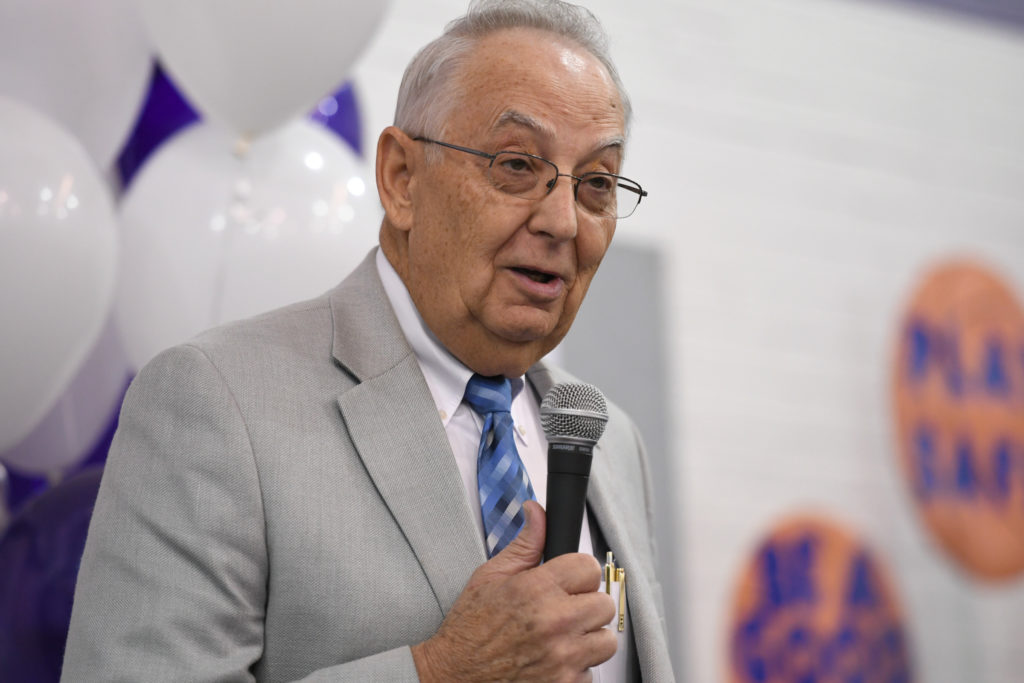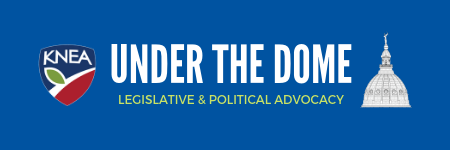
KNEA was asked by Senator Molly Baumgardner (R-Louisburg), chair of the Senate Education Committee, to bring information on teacher salaries to the committee.
We focused on starting salaries although we also shared information about what it takes to reach the higher pay levels in districts. KNEA has for several years been working a project to bring all districts in the state to a minimum starting salary of $40,000.
Among the data we shared was a state map of school districts showing where the $40,000 goal had been met. The map shows that the bulk of such districts are in the southern half of the state and eastern ¼ of the state. We also pointed out that- along the northern border of the state- teacher salaries tend to be quite low with only two districts along the highway 36 corridor hitting the $40,000 mark – Hiawatha USD 415 and Norton Community USD 211. Those two districts just joined the $40,000 “club” this year with the money received under the 2019 school finance bill. Both put significant new resources into teacher salaries.
We wondered what could explain the exceptionally low salaries along that stretch of Kansas highway as did one Senator who asked if the real reason for low salaries along the Highway 36 corridor is due to the fact that these are rural communities with not a lot of students.
In response, we pointed out that Hiawatha and Norton had decided to prioritize teacher salaries and they are both rural. Additionally, rural southeast Kansas, an area also impacted by poverty, 15 districts had reached the $40,000 mark and an additional 11 were paying at least $38,000. In rural northwest Kansas USD’s 352, 315, 316, 241, 274, and 466 are all at a minimum of $38,000 with two of them at $40,000. All are rural communities that have competitive teacher salaries.
So we wonder, just as the Senators do, why one portion of the state pays teachers so much less than another part. The data shows that it is not a matter of rural versus urban or suburban. It’s not poverty versus wealth. What is it, then?
We wondered aloud if- perhaps- some communities valued their public schools- and the dedicated people who work in those schools- less. We don’t have all the answers to these questions, but what we do know is that educators who have worked to achieve high levels of education as professionals and those who work to support our students every day, in too many Kansas school districts, are paid too little given the demands on them.
We want answers. We have a severe teacher shortage in Kansas. Enrollment in teacher preparation programs is in decline. Far too many teachers leave the profession after just a few years. Salaries in Kansas are too low to recruit and retain the best teachers for our classrooms. The proof is there. Now what are we going to do about it?
KASB (Kansas Association of School Boards) was asked to present data on superintendent salaries. This data is sometimes hard to pinpoint due to issues of reporting. If you look at some salaries over a five year period, you will see very large pay increases. Yet some show decreases by nearly 50%. What is not reported is why there would be reductions of such magnitude. We assume that in those cases, the superintendent might be shared between two rural districts. The change would be the result of moving from one district to two and splitting the salary. There are also occasions where a rural superintendent might be serving in other capacities as well – perhaps as a building principal or special education director. In a district that reduced an administrative position and assigned those duties to the superintendent, some of the salary for that position might have gone to the superintendent with those additional duties. Yet it is all reported as the superintendent’s salary.
It would be very helpful to have each of those salaries reported according to the full scope of duties. This data needs a lot more disaggregation to be really helpful.
During the second day of the hearing, the committee heard from Dale Dennis, Deputy Commissioner of Education and Kansan of the Year.
Dale brought the committee plenty of “numbers” including school funding totals; FTE enrollment totals; certified and non-certified staff totals; CTE enrollment and certificate completion totals; changes in the number of counselors, psychologists, and social workers, graduation rates; ACT trends; pupil-teacher ratios; state assessment results; and how general and supplemental general expenditures were impacted by increased funding for 2019-20.
Committee members had plenty of questions on the whole range of topics.
Most notable was a discussion of following student groups year to year to determine school effectiveness through assessment scores. Senator Bollier (D-Mission Hills) pointed out the importance of tracking only those students who are continually enrolled. Comparing the performance of a cohort of students in third grade with the performance of those same students in fourth grade and beyond demands that we filter out those students who are new to the school in the fourth grade.
Bollier also questioned the usefulness of general teacher-pupil ratio figures since they don’t account for how the district might choose to staff their schools. For example, a district might intentionally maintain a lower ratio in the primary grades than in the secondary schools or deliberately staff core classes with lower ratios than elective classes.
Overall, the presentations and discussions have given committee members more than enough data to consider as they move forward during the session.


